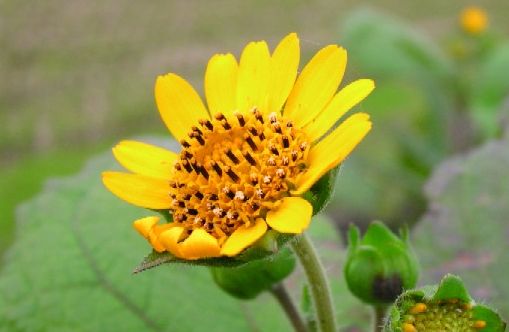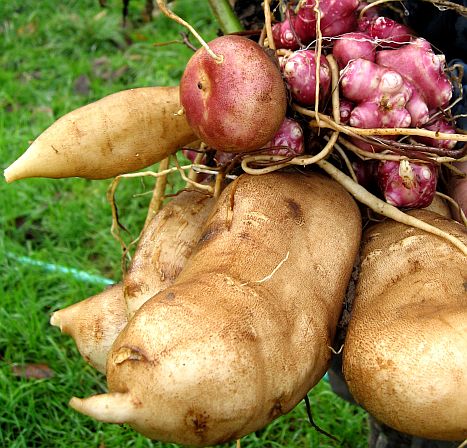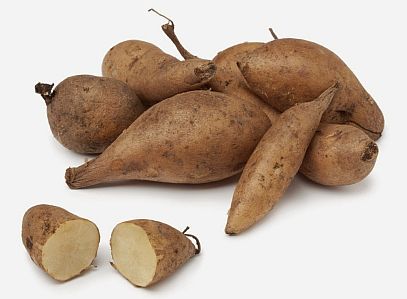Yacon
What is Yacon?
Yacon, which may more commonly be known as the Peruvian ground apple, is a plant native to South America and grown for its crunchy tuberous roots. This perennial plant can easily be identified by its small, yellow, daisy-like flowers surrounded by dark green leaves. It may grow to over 2 meters in height and happens to belong to the same family as sunflowers. It also happens to be pest-free and drought resistant, and so can be easily grown almost anywhere all year round as long as there is no frost. Yacon roots are sweet-tasting and crisp; they are described as a sort of winter delicacy in spite of being a vegetable.
The yacon plant produces two types of underground tubers. The first type consists of rhizomes that are red in colour and grow close to the surface. They are sometimes eaten but are mostly used for planting more yacon. The other type consists of brown colored tubers which are larger in size and the ones you want to eat. From these very same tubers, yacon root extract can be drawn and turned into thick syrup known as yacon syrup, which has important physiologic effects on the human body.

The Yacon flower resembles a sunflower
Where does Yacon grow?
The yacon plant has been traditionally grown by farmers on the eastern slopes of the Andes. The plant is well-adjusted to the ever-changing weather of the Andes, growing as easily in sub-tropical climate as the cooler temperatures in central Andes. Extremely dry and cold weather can cause the aerial yacon leaves to die but the rhizomes remain beneath the soil and sprout as soon as the temperature and moisture content becomes more favorable. Even though frost can deter its growth, not much else seems to affect it. Not only does it seem to be pretty drought-resistant, it can also grow easily on poor soil that tends to give other plants a harder time. Due to its ability to adapt to different climates and weathers, the yacon plant can be grown to produce a commercial yield almost everywhere.
How to grow Yacon?
The small, red yacon root tubers that grow superficially beneath the soil can be used to plant more yacon. Simply wash off the soil and cover them with slightly damp sand or sawdust, making sure to keep them away from the sun. Keep them in a dark corner of the shed, preferably one that is completely dry. If you live in a cold area where the rhizomes would not be safe from the cold, it would be better to store them in Styrofoam boxes and planted when the frost goes away. Check on them and as soon as they begin to sprout, they are ready to be planted wherever you want!
First prepare the soil in which it will be planted by loosening it and adding some compost with a fork. While the yacon is known to grow in poor soil it flourishes best in rich and well-drained soil. Once the soil has been prepared, plant a large rhizome with several sprouts in the soil to a depth of about 3 cm. Now mulch over it well, allowing the conservation of moisture and increased fertility of the soil. Don’t worry if it looks like the layer is too thick, the sprouts will poke through easily without any help. As for weeding, that’s another thing you won’t have to worry about much as the yacon plant forms a dense shade as it grows, preventing the growth of any other plant near it. However, due to this same property, make sure to plant yacon at least 0.5 meters apart. A last piece of great news, the yacon plant is completely pest free!
How to harvest Yacon?
Six to seven months after you planted the yacon tubers, the plant will have become mature. The tubers are to be harvested once the flowering top withers and dies. You will notice that the soil around the base of the plant will start to seem like its being tugged at. Once that happens you can dig a little around some of the superficial immature tubers to allow them time to mature further. As the plant dies the yacon tubers become sweeter, however be careful not to leave the tubers in for too long. In places with mild winters, the tubers begin to sprout again due to suitable temperature and moisture. To harvest the tubers, dig carefully around them being careful not to damage them with your spade. Again separate the small, red rhizomes and keep them in a dark place for later propagation. As for the brown tubers, you can leave them in the sun to sweeten and enjoy the crispy juiciness of your home grown yacon fruit! (Well technically, it’s a vegetable.)

Large Yacon tubers and the connecting red rhizomes
How to Eat Yacon?
Yacon is well known for its crunchy, juicy and fruit-like sweet flavor. The most preferred way of eating yacon is in its raw state. First remove the outer dark skin and then inner white skin to yield a scrumptious and appetizing pulp. It can be enjoyed as a simple snack or even in salads, but it should be added in the last minute before serving as it gets brown quickly once peeled. Addition of citric acid, for instance lemon juice, prevent it from discoloration. Peeled and chopped yacon mixed with other fruits, particularly mango and pineapple, makes an ideal salad during summer.
You can also boil, steam or bake yacon root according to ones convenience and taste. It can be used in pie or can be made into a jam or syrup. You can make yacon a part of your daily diet through various mediums for it is available in the form of yacon tea, yacon chips, and numerous recipes.
There are an assortment of yacon health benefits, and the root itself is very low in calories making it a perfect ingredient for those wanting a low calorie diet.
What are the health benefits of Yacon?
Some of the most popular yacon health benefits include the control of blood sugar levels, control of cholesterol level, boosting immune system and helping in weight loss. The yacon root is full of health benefits some might be undiscovered but let’s take a look at a few ones.
- Potential Weight Loss Aid: Yacon is a potential weight loss agent therefore known as “Diet potato”. It is a low calorie root and it is made up of fructooligosacharide which helps one to feel full longer.
- Control Of Type II Diabetes: Yacon contain inulin, which is a type of fructose found in the yacon tuber. Some researchers have claimed that it’s useful in insulin independent diabetes, such as type II diabetes for regulating blood sugar levels. Research is still being continued and researchers are striving to document any importance of this plant in diabetes, which could be revolutionizing in the field of medicine as a therapeutic agent.
- Used As Natural Sweetener: They can be used in the preparation of sugar free sweeteners for diabetic patients and those who are motivated to lose weight. You can also add yacon sweetener in coffee and tea.
- Cancer Prevention: It is a potent anticancer agent for it inhibits the proliferation of mutant cells by initiating apoptosis (programmed cell death). It is found effective against skin, colon and blood cancer.
- Prevention Of Fatty Liver: Yacon is an important regulator of body fat and prevent excessive cholesterol accumulation, thus protecting liver function by assisting it in cholesterol metabolism. It helps in metabolic processes of body.
- Reduced Triglycerides: Yacon contain fructooligosaccharide that lowers bad cholesterol (triglycerides and low density lipoprotein). Low level of triglyceride is associated with reduce risk of heart attacks and stroke.
- Prebiotic Effects: It is associated with correction of digestion by increasing intestinal flora and preventing colitis.
- Cure For Constipation: It is a used to increase intestinal motility thus reducing constipation.
- Antioxidant Activity: Chemical analysis of yacon has shown antioxidant activity which prevents the body from inflammatory and chronic diseases. This is one of the chief yacon root benefits. These antioxidants were extracted by methanol from the yacon plant. Caffeic acid, Ferulic acid and Chlorogenic are the anti oxidants found in the leaves of yacon.
- Anti Fungal: Yacon leaves have reported important anti fungal effects. The yacon leaf may be used in the treatment of fungal diseases like athlete’s foot.
- Tribal And Herbal Medicine: In South America, yacon plants are used as tribal medicines for kidney and bladder problems and also for cystitis, nephritis and externally for myalgia.

Many great health benefits of Yacon.
Scientific studies on the Yacon root
- According to a study carried out in 2013 by Delgado et al, ingestion of fructooligosaccharide and inulin improves the growth of bifido bacteria in the colon- part of the normal flora in our intestines that help us with digestion. Not only that but eating yacon benefits us by an enhancement of mineral absorption and overall improvement of gastrointestinal metabolism, along with playing a role in the regulation of serum cholesterol. It doesn’t even stop here! Eating yacon root benefits us by infusing our blood with prebiotics that nurture the immune system, improving the body’s ability to resist infections and allergic reactions.
- Another study done by H Satoh et al, on rats confirmed beliefs about the benefits of yacon diabetes being in consideration. Not only is yacon a great substitute for sugar for the use of diabetic people, as it contains inulin and can be used as a yacon sweetener, but also the results of this study showed that yacon feeding reduced blood glucose due to its beneficial effects on hepatic insulin sensitivity in diabetic people.
- A yacon study done on mice with induced diabetes showed that yacon increased sperm count and reduced glycemia.
- In 2009, a study by Genta S et al, showed that daily consumption of yacon syrup by obese pre-menopausal women lead to a significant decrease in body weight, waist circumference and body mass index. A decrease in fasting serum insulin and an increase in satiety sensation were also seen.
- A study published in 2015 investigated the effects of yacon based products on how it can affect constipation. The yacon based product showed it could actually ease constipation symptoms.
What are the side effects of eating Yacon?
Despite of its usefulness there might be a few side effects. Some reported side effects are:
- Allergic Reactions – There have been one reported case of an allergic reaction to yacon extract.
- Intestinal pain and loose stool – If you eat to much it can cause pain in the intestines. Some people have also reported having loose stool after consuming yacon syrup.
There have been studies conducted on Yacon syrup using a dose of 0.29 g and 0.14 g fructooligosaccharides per kg of body weight per day. The upper limit did cause undesirable gastrointestinal effects for some people, but the lower level worked well. However, eating yacon raw or cooked should not cause in problems since the concentration in ructooligosaccharides is less in volume.
Conclusion
Yacon is an important plant with loads of therapeutic and physiologic effects. Numerous researches are carried out to analyze the usefulness of this plant and to further use these outcomes in the field of medicine and everyday life. Some things are proven and others are still in process but there is a promising future of this plant in human life.

 Facebook
Facebook  Twitter
Twitter  RSS
RSS







